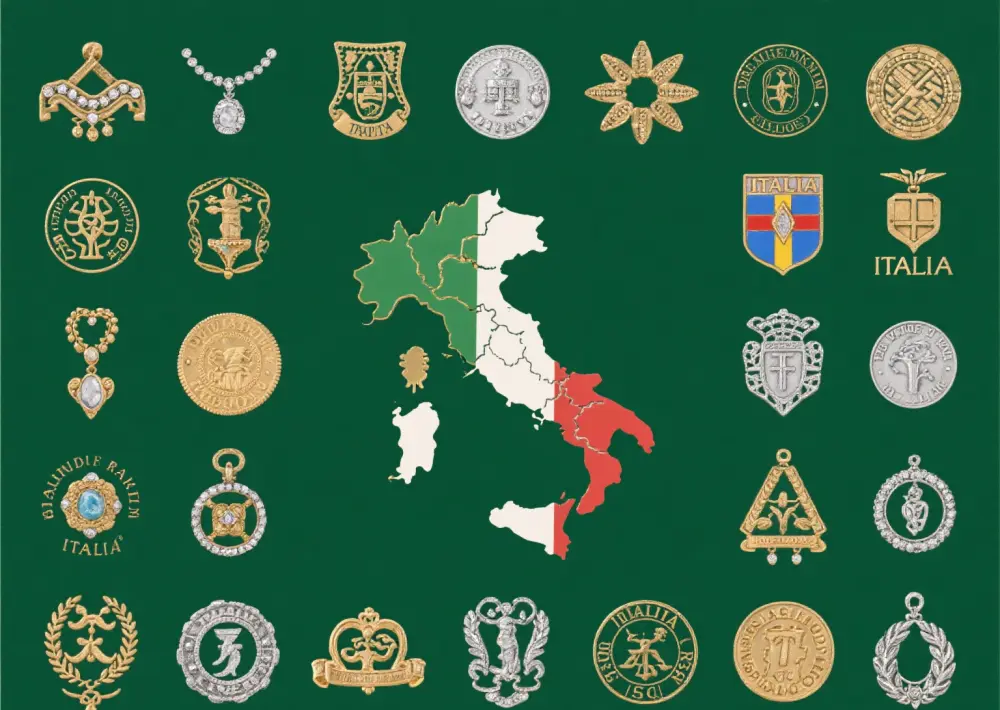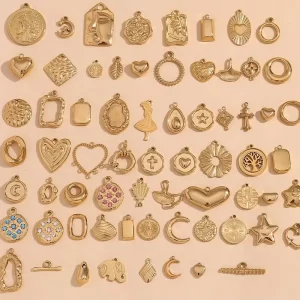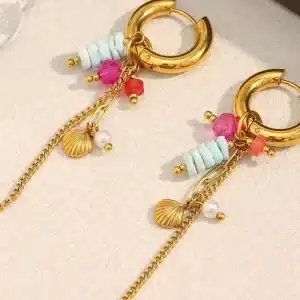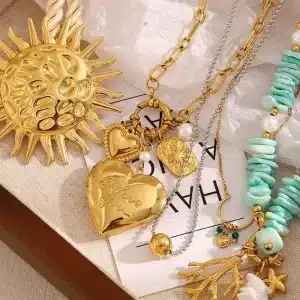What Does 925 Italy Mean on Silver Jewelry? Find Out Here!

Table of Contents

Key Takeaways
- The 925 means that the silver is at least 925 parts per 1000 pure silver, so it is a very standard quality.
- From a durable standpoint, sterling silver is often mixed with metals like copper and zinc to make the jewelry stronger, yet maintain its worth.
- Genuine 925 Italy jewelry is renowned internationally for its craftsmanship, frequently embodying Italy’s historic legacy, local stylistic influences, and contemporary design advancements.
- Here’s how to check if these are real: 925 Italy stamp, weight, magnet and jewelers.
- Maker’s marks and provincial symbols on Italian jewelry offer a wealth of insight beyond what’s visible to the naked eye, indicating origin, craftsmanship, and authenticity — guiding buyers in making informed choices.
- Although 925 Italy jewelry isn’t pure silver and can tarnish, its blend of quality, tradition, and timeless elegance makes it a treasure for consumers worldwide looking for both beauty and investment value.
The ‘925’ marks the metal as 92.5% silver, with the balance usually made up of other metals for durability. Italian silver is renowned for its fine workmanship and quality. Folks identify with this stamp when they’re seeking fashion AND substance. The following two sections explain what this implies for purchasers.
What 925 Italy Jewelry Means

The “925 Italy” stamp on jewelry signifies that the piece contains at least 92.5% pure quality silver and originates from Italy or an Italian jewelry brand. This hallmark serves as an international symbol of excellence, linking the jewelry to a rich tradition of italian silversmithing and exceptional craftsmanship. Understanding this is essential to grasp what does 925 Italy mean on silver jewelry.
1. The Silver Standard
The ‘925’ in ‘925 Italy’ denotes that the jewelry is sterling silver. 925 Italy Jewelry Sterling silver is 92.5% pure silver mixed with 7.5% other metals, such as copper or zinc. This mix makes it durable enough for everyday use, as pure silver on its own is too soft and malleable.
Knowing the silver content helps you gauge the true worth of an item. When you see “925 Italy,” you know you’re receiving a high silver content, not a cheap alloy. For instance, a ring or chain stamped ‘925 Italy’ will endure longer and retain its luster more than a piece with a lesser purity stamp.
2. The Italian Mark
The “Italy” portion of the stamp means more than just a location. It indicates a link to the storied tradition of Italian craftsmanship and design in the jewelry arts. Even if it’s not totally made in Italy, that Italian design or brand carries with it a quality reputation. Some of the best jewelry brands from Italy– whether spotted in international cities or on the web– have been trendsetting jewelry worldwide.
Understanding What Does 925 Italy Mean on Silver Jewelry is essential for anyone interested in quality silver pieces.
Understanding What Does 925 Italy Mean on Silver Jewelry can greatly enhance your appreciation of these exquisite pieces.
What Does 925 Italy Mean on Silver Jewelry? This important question underlines the significance of the 925 stamp and its implications for buyers seeking quality silver jewelry.
Italian craftsmen work with attention and precision. You’ll frequently observe special textures, sleek finishes and classic aesthetics in their designs. To wear jewelry stamped ‘Italy’ is to wear taste, the country’s influence emerging in styles both traditional and contemporary.
3. A Quality Promise
A “925 Italy” hallmark is a guarantee. It says that rigorous standards of silver purity and Italian artistry were achieved. It’s normally stamped in a convenient spot that’s simple to verify but doesn’t detract from the aesthetic.
Understanding What Does 925 Italy Mean on Silver Jewelry helps consumers make informed decisions about their purchases and appreciate the value of their jewelry.
They do have fakes out there. Real “925 Italy” jewelry will always feature a crisp, legible hallmark. Quality is in the weight, finish and durability of the piece. Many global manufacturers, such as HonHo Jewelry Manufacturer, use these standards to make sure their sterling silver pieces meet what buyers expect. Companies like this meld traditional craftsmanship with modern technology to deliver you exquisite, enduring jewelry.
To sum up, understanding What Does 925 Italy Mean on Silver Jewelry is essential for recognizing quality craftsmanship and ensuring you invest wisely in your jewelry collection.
Understanding What Does 925 Italy Mean on Silver Jewelry is essential for anyone looking to invest in quality pieces that reflect both beauty and craftsmanship.
The Legacy of Italian Craftsmanship

There’s a tale of craftsmanship, heritage, and an attention to detail that’s the cornerstone of Italian jewelry. The “925 Italy” hallmark, often found on quality sterling silver items, ties every piece to a legacy of meticulous craftsmanship and artistic innovation. Italian silversmiths have earned a world-class reputation for blending old and new, tradition with style.
Historical Roots
Italian goldsmithing dates back to antiquity. Etruscan and Roman goldsmiths forged implements and jewelry that continue to influence modern patterns. Their filigree, granulation, and chasing established the foundation for centuries of advancement.
Over the course of time, Italy encountered tides of change. The Middle Ages introduced new styles associated with religion. The Renaissance ignited an artistic explosion, with figures such as Benvenuto Cellini influencing art and jewelry alike. Through these periods, Italian craftsmanship became more adept and diverse, ever connected to significant happenings and cultural movements.
Pivotal characters like Cellini and the Castellanis left their imprints. Their craftsmanship injected fresh thinking, honed ancient expertise and set higher standards for quality and design. Jewelry was often used in ceremonies and religious rites, as well as a status symbol.
Regional Styles
There are so many local styles in Italy. Florence for engraved gold and elaborate silver. Venice flaunts glass beads and filigree. Sicily melds Greek, Arab and Norman accents in its colorful jewelry. Every region is endowed with a different appearance, a diverse character forged by its historical and cultural background.
Local materials count. Tuscan gold, Venetian glass and coral from the Mediterranean all infused with that extra-special something. Craftsmen consume these materials, laboring with techniques handed down from one century to the next. The outcome is jewelry that’s simultaneously local and timeless.
Craftsman from every province shape Italian jewelry’s aesthetic. They keep the craft vibrant and diverse. This variety is a power, demonstrating the breadth of Italian tradition.
Within this legacy, global manufacturers such as HonHo Jewelry Manufacturer draw inspiration from Italian methods. HonHo harmoniously combines ancient craftsmanship with modern innovation, producing 925 silver jewelry that adheres to high quality and design standards.
Modern Innovation
Contemporary Italian designers marry the traditional with innovation. They employ pure lines, strong forms, and new materials, while maintaining a link to tradition. Brands and makers employ CAD tools and laser engraving to achieve new degrees of specificity.
The technology assists but doesn’t substitute for masterful hands. Italian artisans continue to polish, engrave and set stones by hand, ensuring that value remains high. A lot of use alloys to make sterling silver more durable.
Innovation, after all, is what keeps you contemporary. Italian clothing houses and jewelers are at the forefront of new trends, while still emphasizing the meticulous labour that is the hallmark of their art.
Timeless Artistry
Italian jewelers craft to endure. Their pieces exhibit thoughtful styling, finely crafted setting, and a passion for intricacy.
Every piece tells a story—of culture, skill, and pride.
How to Verify Authenticity

To check for authentic Italy silver jewelry, careful observation and easy techniques are essential. Knowing what to look for can help you avoid counterfeit pieces and shop smart. A sterling silver item stamped ‘925 Italy’ signifies that it contains 92.5% pure silver and was crafted in Italy, but not every piece with this hallmark is genuine. Follow these steps to ensure authenticity.
- Search for a distinct “925 Italy” hallmark, typically on the interior or bottom.
- Check the jewelry’s workmanship and finish for indicators of being handcrafted.
- Sense the weight– genuine articles tend to be hefty when contrasted with fakes.
- Use a magnet; real sterling silver is not magnetic.
- Check for strong odors—genuine silver should have none.
- Do a rub test: real silver leaves dark marks on a cloth.
- Beware of prices that seem far below market value.
- Inquire about the article’s provenance and composition if you can.
Examine the Stamp
Verify the jewelry for a ‘925 Italy’ mark. The mark must appear sharp, distinct and not readily removable. This hallmark is a fast way to validate the metal’s purity, but imitations are out there.
An actual stamp is worked deep into the metal, and stands the test of years. If it appears faded or blotchy, be wary. Some counterfeits employ feeble stamps that wipe off after a couple of wearings.
There can be other stamps next to “925 Italy”. For instance, you may find the brand name, a maker’s mark or a logo. These additional credits can lend authority, but double-check them! Counterfeiters attempt to replicate these items, so look carefully.
Feel the Weight
LIFT – grab the jewelry and feel its weight in your hand. Genuine sterling silver, for example, tends to feel weightier than inexpensive metals or plating. If a bracelet or chain is too light, it might not be the genuine article.
Weight can tell you a lot about what’s inside. Cheap alloys or hollow pieces feel wimpy. If you can, compare a few, side by side. Genuine silver has a weighty, premium feel.
Use a Magnet
Magnet test is fast—simply hold a small magnet close to the jewelry. True sterling silver won’t, while fake metals or plated items might adhere.
Silver isn’t magnetic due to its atomic structure, which distinguishes it from a lot of typical metals. This test may sift out the obvious fakes, but be warned it’s not infallible. Some plated items utilize non-magnetic metals as well.
Pair this technique with other, such as halmark and weighing, for a more comprehensive view.
Consult an Expert
Consult a reputable jeweler for assistance if you’re uncertain. Experts can identify fraudulent work and respond to inquiries regarding provenance or media.
A professional appraisal can provide peace of mind and could be worth the cost. Their perspective brings a degree of credibility, particularly when it comes to premium buys.
Even a quick convo can educate you on what to search for in your next jewelry purchase.
The Story Behind Your Stamp

The ‘925 Italy’ stamp on your jewelry signifies more than just a label; it represents quality silver with a purity of 92.5%, usually with copper as the balance. This hallmark not only indicates the origin of the piece but also provides insights into the craftsmanship of Italian silversmithing. A good hallmark helps buyers avoid counterfeit items, ensuring they own authentic pieces of fine jewelry.
Maker’s Marks
Maker’s marks, also known as jewelry hallmarks, are tiny IDs from the jeweler or workshop. These marks can take the form of initials, logos, or symbols, and each one is registered, ensuring no two jewelers have the same. Such silver markings can speak volumes about the gems and often connect to renowned Italian goldsmiths or generations-old family workshops. An item boasting a recognizable maker’s mark, such as an Italy silver chain, is typically worth more, indicating quality craftsmanship.
Knowing maker’s marks assists purchasers in identifying genuine Italian items, including quality sterling silver pieces. Famous examples like the “UnoAErre” of Arezzo or the “VI” of the Vicenza workshops highlight the importance of understanding these marks to choose quality jewelry and avoid counterfeit products.
Ultimately, maker’s marks provide authenticity and value, making them crucial for both new and vintage jewelry lovers. Recognizing these imprints can help individuals appreciate the exceptional craftsmanship behind fine jewelry.
Provincial Symbols
Provincial signs indicate where in Italy the jewelry is from. These could be letters, numbers or symbols representing a town or area, such as Florence, Vicenza or Arezzo.
These cancellations are more than just place names. Italian regions have styles, handed down through families. A stamp from Florence would incorporate traditional Renaissance motifs, while one from Vicenza may have sharp, contemporary edges. These marks are a salute to the local artistry and to regional pride.
Consumers who seek out these icons can discover the scope of Italian jewels. They are able to coordinate their flavor to a region’s fashion and select items with significance. These marks link the jewelry back to its origins and demonstrate the craftsman’s reverence for his art.
Stamp Variations
The ‘925 Italy’ stamp can vary in appearance from one jeweler to another, especially when it comes to quality silver items. Some may be simple, while others might feature decorative shapes, frames, or additional codes. For instance, a silver chain necklace from Milan may display ‘925 ITALY’ in a rectangle, whereas a ring from Naples could simply have a plain ‘925’ with a small ‘Italy’ beside it.
Some jewelers incorporate their unique flair into the stamp, making each piece distinct and trackable. These subtle variations are natural, but it’s essential for shoppers to understand what to expect. To identify authentic pieces, it’s advisable to check guides or compare jewelry hallmarks to avoid counterfeit products, especially when purchasing quality sterling silver.
Stamp variations are important to know when purchasing. It assists purchasers to identify genuine Italian silver and not succumb to knock-offs, which are rampant in a lot of markets.
Researching Stamps
Digging into jewelry stamps, especially those related to quality silver and Italy silver chains, rewards enthusiasts. Check marks with online databases or books, and consult experts or jewelers for assistance if you’re not sure.
Debunking Common Myths

There are a lot of myths about 925 Italy silver jewelry. Separating fact from fiction can aid you in selecting quality sterling silver jewelry, be it for everyday wear or a special occasion, with a more intelligent approach. Below is a breakdown of the most widespread myths and the real facts behind them.
-
Myth: All 925 Italy jewelry is pure silver. Actually, it’s 92.5% silver and 7.5% other metals, typically copper.
-
Myth: 925 silver is not durable. Sterling silver is surprisingly tough and durable, ideal for day-to-day use.
-
Myth: 925 silver always tarnishes badly. Tarnish does, of course, occur, but with attention, the article remains luminous for decades.
-
Myth: All 925 Italy jewelry is handmade. Hand made or machine made, you can have both quality and style.
-
Myth: 925 silver jewelry is only for special events. With its power and unisex style, it matches everyday wear.
-
Myth: 925 silver is not valuable. The sterling and workmanship bring actual value to every piece.
-
Myth: Authenticity is a given. There are counterfeits, so verify with stamps or have it tested.
-
Myth: 925 silver has a strong smell. Real ones don’t smell.
-
Myth: Maintenance is hard. Care is easy and makes jewelry last.
Not Pure Silver
925 Italy jewelry isn’t actually pure silver! Each piece contains 92.5% quality sterling silver alloyed with 7.5% other metals—usually copper. This alloy is essential since fine silver is too soft for the majority of jewelry, including silver chain necklaces. Incorporating copper or another metal, however, makes the jewelry more practical and durable for everyday use. Some folks fear the blend dilutes worth, but the supplementary metals don’t decrease quality; they enhance the exceptional craftsmanship of the jewelry.
It Can Tarnish
Every silver jewelry 925 Italy can tarnish. That’s the reactions with air, moisture and even skin oils. Tarnishing appears as a dull or darkened surface. Even fine silver will tarnish. This doesn’t necessarily mean the piece is dead. Simple steps help prevent it: keep jewelry dry, store it in closed pouches, and clean it with a soft cloth. Mild soap and water does the trick. With proper maintenance, 925 silver maintains its luster and endures for ages.
Tarnish doesn’t equal lousy. In fact, that’s why so many opt for 925 Italy jewelry in daily life – it retains its appearance so nicely. If you want jewelry with extra protection, some brands like HonHo Jewelry Manufacturer offer finishes that fight tarnish, making upkeep even easier.
Not Always Handmade
Not all 925 Italy jewelry is handmade. Most are fabricated with equipment using contemporary methods. This enables new designs and more competitive pricing. Hand crafted still exist, flaunting talent and heritage, but machined bits can be just as great. The key is the quality, not the technique.
It’s skill that counts. Hand or machine-made one reason and a fine polish is all that matters. Brands like HonHo mix vintage techniques with modern technology to achieve optimal results.
Educate Yourself
Look for quality stamps and silver markings. Request certificates and read up on the maker.
The Value of 925 Italy Jewelry
What does the “925 Italy” stamp on my jewelry mean? It’s a mark you can rely on for quality sterling silver, design, and authenticity. Purchasers and collectors view these quality jewelry items as more than just jewelry; they are a marriage of fine metal, artistry, and tradition. The worth of 925 Italy silver jewelry depends on several factors—not just the silver chain necklace itself. Below is a table that breaks down the main factors.
|
Factor |
Description |
|---|---|
|
Silver Content |
92.5% pure silver, 7.5% other metals, standard for sterling silver |
|
Craftsmanship |
Italian artisans are known for detailed work and innovative designs |
|
Brand Reputation |
Recognized brands and reputable makers command higher prices |
|
Weight |
Heavier items have more silver and tend to be more valuable |
|
Condition |
Well-kept pieces retain value; tarnish or damage lowers resale potential |
|
Rarity |
Limited or unique designs are often worth more |
|
Authenticity |
Verified by “925 Italy” mark, smell test, or magnet test |
Intrinsic Worth
- Silver purity: Marked as 92.5% pure silver
- Place of origin: Made in Italy, a country famous for jewelry making
- Heavier chains: More silver, higher material worth
- Craftsmanship: Detailed, creative designs
- Brand reputation: Trusted brands can boost value
- Authenticity: Confirmed by proper marks and simple tests
Design and artisan craft push inherent value higher. Italian manufacturers frequently employ craft handed down through families. Details and finishes pop, making even plain chains covetable. Famous brands or workshop pieces can be many times more valuable than generic ones.
Brand name counts. Consumers are willing to pay a premium for names they trust. Or even better, jewelry from a respected brand or maker holds up well in the market. It provides consumers with confidence in their purchase.
Jewelry is not simply for fashion. It can be a fine investment, as well. Think about style and think about value retention.
Resale Potential
-
Brand: Pieces from famous makers retain value.
-
Condition: Flawless items sell for more.
-
Documentation: Receipts, certificates, and appraisals matter.
-
Rarity: Unique or hard-to-find designs are sought after.
Condition and rarity impact resale price. Even a simple chain will bring in a great deal of money if it’s heavy and in excellent condition. Designer and fancy pieces, occasionally valued at a few hundred, are popular.
Maintain paperwork. Consumers believe in jewelry that they know where it came from and what it’s worth. This may consist of appraisals or original receipts.
Collectors and fans seek genuine italian silver. There will always be a market for actual 925 Italy items, especially unique or vintage ones.
Lasting Appeal
925 Italy jewelry is timeless looking. It wears beautifully with everything and hardly ever goes out of style. This makes it a sustainable option for many.
Fine workmanship ensures these beauties endure. Silver doesn’t rust, and good finishes fight tarnish. Some pieces, like those from HonHo Jewelry Manufacturer HonHo Jewelry Manufacturer, use advanced methods to make sure the jewelry stays bright and strong.
Jewelry means more than price. Some become family heirlooms.
929 Italy Jewelry the smart choice – pieces that hold both beauty and value.
Differences Between Gold and Silver
Gold and silver are popular metals in jewelry, each with distinct characteristics and values. While both can be stamped, such as with an “925 Italy” marking, the meanings differ significantly. Understanding these differences is crucial for jewelry lovers to make informed choices regarding price, style, and care. For instance, a quality silver item can often be more affordable than its gold counterparts, but both hold their unique appeal.
Gold is a precious, soft metal that is naturally yellow and doesn’t tarnish. Jewelers often mix it with other metals for strength, and its purity is measured in karats: 24 karat is pure gold, while 18 karat is 75% gold. Popular gold colors, like yellow, white, and rose, come from mixing gold with metals like silver or copper. Gold is prized for its lasting shine and value, making it a favorite for wedding bands and luxury items.
Conversely, silver is more common and less expensive. Pure silver is soft and often utilized in jewelry as quality sterling silver, marked “925,” indicating it contains 92.5% silver and 7.5% other metals for durability. Silver jewelry exudes a bright look that complements many styles but may tarnish when exposed to air and water, necessitating more maintenance.
Both metals feature country or purity stamps; however, “925” is exclusive to silver, while gold employs karat or numeric marks. For example, an “750 Italy” marking indicates high-purity gold, whereas “925 Italy” signifies an Italy silver chain made of sterling silver. Recognizing these distinctions aids buyers in selecting the right metal for their jewelry collection.
Maintenance Tips for 925 Silver

925 silver, or sterling silver, is 92.5% silver, with the rest usually being copper. Stamps like “925 Italy” indicate its silver standard and craftsmanship. Although durable, it can tarnish if not cared for.
To prevent tarnishing, keep silver in a dry, cool place using soft cloth bags or lined boxes. In humid areas, add silica gel packs to absorb moisture. Always take off silver jewelry before showering, swimming, or using harsh soaps, as water and cleaners can stain it.
Regular cleaning is important; use a soft, lint-free cloth after each wear, and for tougher dirt, wash with gentle soap and warm water, drying immediately. For stubborn marks, use silver polish or a paste made from baking soda and water—just patch test first.
To avoid scratches, store each piece separately, wrapped in soft cloths or in pouches. If your jewelry has stones, ensure cleaning products are safe for them. For deep cleaning, consult a jeweler, and consider annual inspections to keep your pieces secure.
Conclusion
Reading ‘925 Italy’ on a piece of jewelry reads genuine sterling silver and deep traditions of Italian craftsmanship. That little stamp says it loud–genuine silver combined with fashions that evolved through the years.
Most of us select these pieces for the sparkle, the aesthetic, or the narrative that tag provides. Knowing where to find the right mark, to feel the weight, and to check in trusted shops do help weed out the fakes. Sure, some people think the number or the country name are more important, but it adheres to silver and artisan.
To be a savvy selector, go with reality and believe your eyes and hands. Want to know more or need advice checking your own pieces? Call it, call and keep that true silver quest keen.
Frequently Asked Questions
What does “925 Italy” mean on jewelry?
The “925 Italy” marking indicates that the jewelry is crafted from quality sterling silver (92.5% purity) and is made in Italy, renowned for its exceptional craftsmanship in silver jewelry.
Is 925 Italy jewelry real silver?
Yes, 925 Italy silver jewelry is authentic sterling silver, composed of 92.5% pure silver and 7.5% other metals for quality and durability.
How can I tell if my 925 Italy jewelry is authentic?
Look for a distinct 925 hallmark and shop with trusted dealers of quality silver jewelry. Real stuff is heavy, hard to bend, and doesn’t have an excessive amount of tarnish.
Why is Italian silver jewelry valued?
Italian silver jewelry, known for its exceptional craftsmanship and quality silver, exudes a rich heritage of excellence.
Can 925 Italy jewelry tarnish?
Yes, like all quality sterling silver, 925 Italy silver chains tarnish. Frequent cleaning maintains its brilliance.
Is 925 Italy jewelry hypoallergenic?
Sterling silver jewelry is usually hypoallergenic, but some folks may react to the tiny bit of quality silver, like copper, mixed in.
Does “925 Italy” mean my jewelry is expensive?
The marking ‘925 Italy’ signifies quality silver and origin, with prices varying based on weight, design, and brand.
Share:
More Posts

10 Questions to Ask When Choosing a Jewelry Manufacturer
Key Takeaways Jewelry manufacturer vetting is the quality, ethics and on-time delivery checking of suppliers. It includes material traceability, fair labor, audit history, capacity and

Jewelry Findings Guide: Essentials for DIY & Hypoallergenic Design
Key Takeaways Jewelry findings guide provides concise information on the smaller components used in jewelry manufacture and repair. These pieces are clasps, hooks, jump rings,

Waterproof Jewelry Materials: A Guide for Your Next Vacation
Key Takeaways Waterproof jewelry materials include stainless steel, titanium, platinum, and silicone. These metals and non-metal alternatives don’t rust or dull when worn in water.

Charm Chain Styling: A Guide to Layering and Materials
Key Takeaways Charm chain styling is basically adding little charms to a plain chain in order to create a new look. This method of adorn
Send Us A Message
Related Posts

What Does 925 Italy Mean on Silver Jewelry? Find Out Here!
Key Takeaways The ‘925’ marks the metal as 92.5% silver, with the balance usually made up of other metals for durability. Italian silver is renowned
